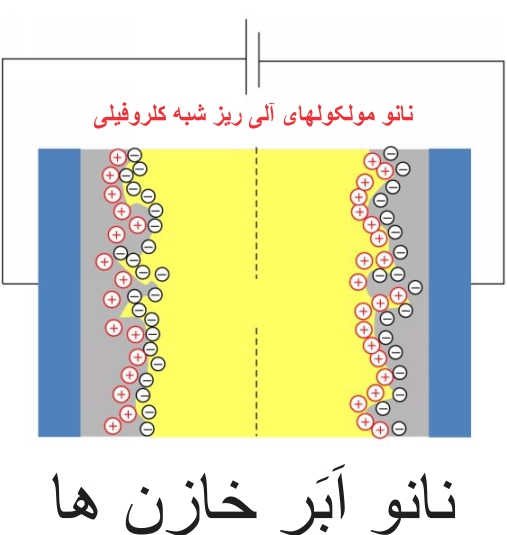Small chlorophyll-like organic nanomolecules in (nanosupercapacitors)
Researcher and author: Dr. ( Afshin Rashid)
Note: In the structure (nano supercapacitors), the electrical conductivity is from a conductor to a semiconductor or an electrically changeable insulator of nanotubes depending on their structure and molecular chiral angle . Since carbon nanotubes are able to pass electric current through their surface by means of ballistic transfer of electrons without friction - this current is a hundred times higher than the current that passes through copper wire - so nanotubes are an ideal choice for making (nano cloud) capacitors) are
Small chlorophyll- like organic nanomolecules in (nanosupercapacitors) are made of carbon nanotubes, although the discovery of small but very resistant, flexible and conductive carbon nanotubes with dimensions equal to DNA strands and the use of molecules Chlorophyll-like micro-organisms instead of charge storage capacitors (nano-supercapacitors) absorb nano-type. Nano crystals, the use of which will increase the lifespan of nano memories.
In fact, by using nano technology, the energy storage capacity can be increased by a thousand times or more. Energy storage is a very important and necessary topic that can be done in different ways through small chlorophyll-like organic nanomolecules in (nano-supercapacitors)One of the new tools for widespread energy storage is the use of nickel quantum dots in nanometer sizes, which are expected to be usedto store tiny organic nanomolecules in (nanosupercapacitors)Regarding (nano supercapacitors), there is a high potential for activity in this field.The structure and structure of supercapacitors based on nanoelectronics store 100 times more charge than electrolyte types in the same volume and charge and discharge at a much faster rate than batteries. Of course, these capacitors still store up to 10 times less charge than some types of batteries in the same volume. According to these characteristics, supercapacitors are used in cases where frequent charging and discharging are required, high charging speed is required, or sudden discharge of the charge is required. (Until now, their main use in the electronics industry has been as a support for nano-supercapacitors .) Nanoelectronics shows a schematic of a supercapacitor. The main idea to achieve high capacitance is to reduce the distance between positive and negative charges in the capacitor. The design of these capacitors is such that the thickness of the dielectric layer in them does not exceed one or more molecules.
Conclusion :
In the structure (nano-supercapacitors), the electrical conductivity is from a conductor to a semiconductor or an electrically changeable insulator of nanotubes depending on their structure and molecular chiral angle . Since carbon nanotubes are able to pass electric current through their surface by means of ballistic transfer of electrons without friction - this current is a hundred times higher than the current that passes through copper wire - so nanotubes are an ideal choice for making (nano cloud) capacitors) are
Researcher and author: Dr. ( Afshin Rashid)
Specialized doctorate in nano-microelectronics





